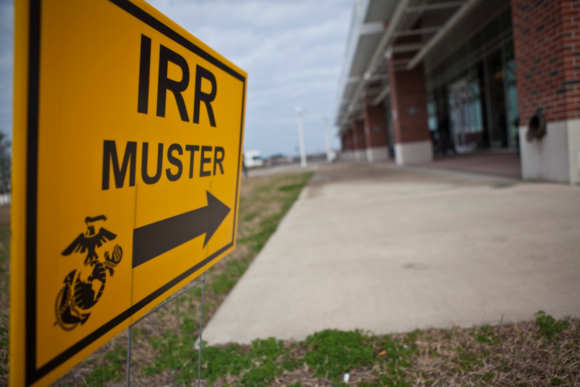The Individual Ready Reserve (IRR) serves to increase active-duty forces rapidly in a time of need. Trained, “on-call” service members make up the Individual Ready Reserve.
Here’s how the IRR relates to other types of military service, how to join the IRR, how to get paid in the IRR, how to earn points, and more.
Table of Contents
- Military Reserve Component Structure
- Who Can Join the Individual Ready Reserve?
- IRR Policy, Service Requirements, and Obligations
- IRR Mustering Requirement
- How Long Are You in the Individual Ready Reserve?
- How Long Can I Serve in the IRR?
- What Do You Do in the Individual Ready Reserve?
- IRR Pay and Benefits
- Do You Get Paid in the Individual Ready Reserve?
- Can You Get a Good Retirement Year In the IRR?
- How to Accumulate Retirement Points in the IRR
- Can You Earn a Military Retirement in the IRR?
- How to Get Out of the IRR
Military Reserve Component Structure
As outlined in 10 U.S.C. Chapter 1005, the IRR is part of the military Reserve Component, which includes Ready Reserve, Standby Reserve, and Retired Reserve forces.
Ready Reserve Component Structure
Ready Reserve forces include the Selected Reserves (what you think of when you hear the term military reserves), the inactive National Guard, and the Individual Ready Reserve.
- Selected Reserves
- Air Force Reserve
- Army Reserve
- Coast Guard Reserve
- Marine Corps Reserve
- Navy Reserve
- Air National Guard
- Army National Guard
- Inactive National Guard: The inactive National Guard (ING) is similar to the IRR but only applies to enlisted members. Inactive Guardsmen are assigned to specific National Guard units but do not participate in monthly training drills. They muster once per year and will deploy with their units when mobilized.
- Individual Ready Reserve: We’ll discuss this component in the sections below.
Individual Ready Reserve Service
Members of the Selected Reserves are in a drilling status: they drill once per month with their units and participate in annual training. This is what most people think of when they hear “one weekend a month, two weeks a year.”
On the other hand, members of the IRR remain strictly in a Reserve status.
They do not receive pay or benefits except for annual musters. They aren’t required to attend monthly training drills, perform annual training, or participate in other military activities.
IRR members may choose to perform drills or certain other military activities. They may receive retirement points, but they won’t get paid.
IRR members can still be activated or recalled to duty if the president authorizes it under a Presidential Reserve Call-up Authority. According to the United States Code, this authority allows the president to activate up to 30,000 members of the Individual Ready Reserve.
If this happens, you’re unlikely to deploy with your original unit.
Who Can Join the Individual Ready Reserve?
You may automatically transfer into the IRR when you separate from active duty or stop drilling in the National Guard or Reserves.
Whether or not you automatically transfer to the IRR depends on how much of your original service commitment you fulfilled.
Remember when you signed your initial military contract?
If you read the fine print, you may have noticed that you signed an eight-year service obligation, even if your active-duty commitment was only three, four, or six years.
This eight-year period is your military service obligation (MSO) under Section 651 of Title 10 USC. Once you complete your active-duty service commitment, you must finish the remaining commitment.
If you served on active duty, you can do this in the Selected Reserves (your branch of service’s Reserve force or National Guard) or transfer into the IRR. Reserve service members who stop drilling serve the remainder of their commitments in the IRR.
Should I Join the IRR?
If you haven’t completed your service obligation, you might not have a choice.
If you don’t want to join the IRR, you can re-enlist or extend your contract to cover your remaining time. By doing so, you can continue to receive drill pay for your time while you complete the last few years in a Selected Reserve status.
Keep in mind that you must continue to train and drill in the Selected Reserves. You’re also more likely to get called up for a deployment – though your unit’s operational tempo can offer some predictability.
One key difference between serving in the Selected Reserves and the IRR is who you deploy with if mobilized.
You’ll likely mobilize with your unit in the Selected Reserve unless you mobilize as an “individual augmentee” attached to another unit. In the IRR, your branch could assign you to any unit that needs someone in your field or specialty.
IRR Policy, Service Requirements, and Obligations
Individual Ready Reserve service requirements may vary slightly by the branch of service, but some requirements are the same for everyone.
For example, the law requires IRR members to maintain possession of their uniforms and their military ID card. They must also keep their branch of service informed of any changes to their home address and other contact information.
Members may also be required to attend musters, complete readiness screenings, or update their personnel or medical records.
IRR Mustering Requirement
Members of the IRR must attend musters so the military can review their records and readiness.
Musters usually take place at regional military bases.
IRR units send IRR members letters or emails with the muster date and reporting instructions. Members must show up to muster at the provided date and location to provide personal and medical information and sign various bits of paperwork.
Some units allow IRR members to muster online but don’t expect it in every unit. Muster practices depend on the branch of service and current policies.
Members receive payment for muster attendance. IRR members who choose to participate in other drills only receive retirement points.
How Long Are You in the Individual Ready Reserve?
Sometimes, you’ll leave the IRR once you finish your service obligation. However, you might be able to remain in the IRR beyond your obligation, depending on certain factors.
How Long Can I Serve in the IRR?
Factors including your branch of service, rank, career field (MOS, AFSC, or rating), and time remaining on your military service obligation determine how long you can stay in the IRR.
The Marines, for example, often allow members to remain in the IRR beyond their MSO date.
According to the Marine Corps Individual Reserve Support Activity (MCIRSA),
“The majority of Marines in the IRR are former active component Marines who have not completed their military service obligation (MSO) yet have completed their initial contractual period of active duty. The remainder of the IRR consists of Marines who have completed their MSO, yet voluntarily agreed to remain associated with the Marine Corps, participating through various means as an IRR Marine or as a “temporary layover” until they can rejoin a selected Marine Corps Reserve unit or acquire an individual mobilization augmentee billet.”
Source: MCIRSA
The Army also allows eligible soldiers to elect to remain in the IRR, according to the Army Reserve Website. However, Navy Personnel Command, staying in the Navy’s IRR after you’ve met your MSO “will not normally be permitted.”
What Do You Do in the Individual Ready Reserve?
Most IRR members only need to report for a muster when ordered. Otherwise, IRR members may pursue their civilian lives as they wish.
Some members may have the option to apply for selective active duty, attend drills, or complete correspondence courses for retirement points.
Can IRR Members Be Deployed?
Yes, under federal law, the president can mobilize up to 30,000 IRR members for up to two years at a time. The president has recalled IRR members to serve during Operations Desert Shield, Iraqi Freedom, and Enduring Freedom, according to Department of Defense records.
Can I Avoid Deployment in the IRR?
IRR members called up for deployment can apply for exemptions to their orders or apply to delay or defer their orders temporarily.
- Delays allow qualified members to put off their mobilization for a short period for professional or personal reasons, such as a wedding.
- Deferments allow qualified members of the IRR to put off their mobilization for a more extended period, usually up to a year. One example might be a college member who will graduate within the year.
- Exemptions essentially cancel mobilization orders for IRR members who can not deploy due to permanent or semi-permanent circumstances that don’t warrant a separation.
IRR Pay and Benefits
Members of the Individual Ready Reserve aren’t typically eligible for payment except for muster, deployment, or another period of active-duty service.
Serving on active duty while in the IRR entitles members to regular active-duty pay and benefits, including base pay, entitlements (BAH, BAS), healthcare, and benefits for their dependents.
Regardless of active-duty orders, all IRR members still have these benefits:
- Military ID for members and dependents
- Base access
- Exchange benefits
- Commissary benefits
- MWR facility and program use
Do You Get Paid in the Individual Ready Reserve?
You only get paid in the IRR when reporting for muster or approved military service. Some members of the IRR are eligible to perform military drills on a non-pay status “for points only,” which does not earn pay.
Can You Get a Good Retirement Year In the IRR?
Yes, earning a good year (50 or more points) is still possible in the IRR. But, it may be more challenging to accomplish than in the Selected Reserve.
Most IRR members do not earn a good year toward retirement.
How to Accumulate Retirement Points in the IRR
You’ll earn 15 participation points each year while serving in the IRR.
To earn a minimum of 50 points, you must perform additional military service.
You can do this by:
- Serving on active duty
- Drilling for points only (in a non-pay status)
- Performing honor guard duty for military funerals
- Attending annual muster
- Completing correspondence courses.
- Some branches have reduced the number of classes eligible for retirement points; IRR members may find it more challenging to earn a good retirement year by taking correspondence courses alone.
Get Your Points Early in Your Retention Year.
Give yourself a buffer period to protect yourself if your situation changes later in the year.
Some National Guard or Reserve members join the IRR toward the end of their careers to pad their retirement points.
In most cases, it’s impossible to earn enough points to increase your pension significantly.
That said, you may find that joining the IRR makes it easier to return to National Guard or Reserve service in a drilling status, provided you’ve maintained your overall readiness.
Can You Earn a Military Retirement in the IRR?
Remember, remaining in the IRR beyond your military service obligation date is uncommon.
If your branch allows it, you may need to earn a promotion to continue serving in the IRR. If you’re not drilling regularly, this could be challenging.
It is possible to retire from the IRR, but if a pension or blended military retirement is your goal, consider remaining on active duty or in the National Guard or Reserves until you have received your 20-year letter informing you that you’re eligible to retire.
How to Get Out of the IRR
For most people, it’s automatic. I had an eight-year military service obligation when I joined the active-duty Air Force.
When I left active duty, I transferred to the IRR automatically. Once I met my MSO, I received a discharge letter from the Air Force Personnel Center. No action was needed on my part.
At that point, I was able to get rid of my uniforms and move on with my civilian life without worrying about any potential mobilizations. Of course, I joined the Air National Guard eight years later, but that’s another story!




About the comments on this site:
These responses are not provided or commissioned by the bank advertiser. Responses have not been reviewed, approved or otherwise endorsed by the bank advertiser. It is not the bank advertiser’s responsibility to ensure all posts and/or questions are answered.